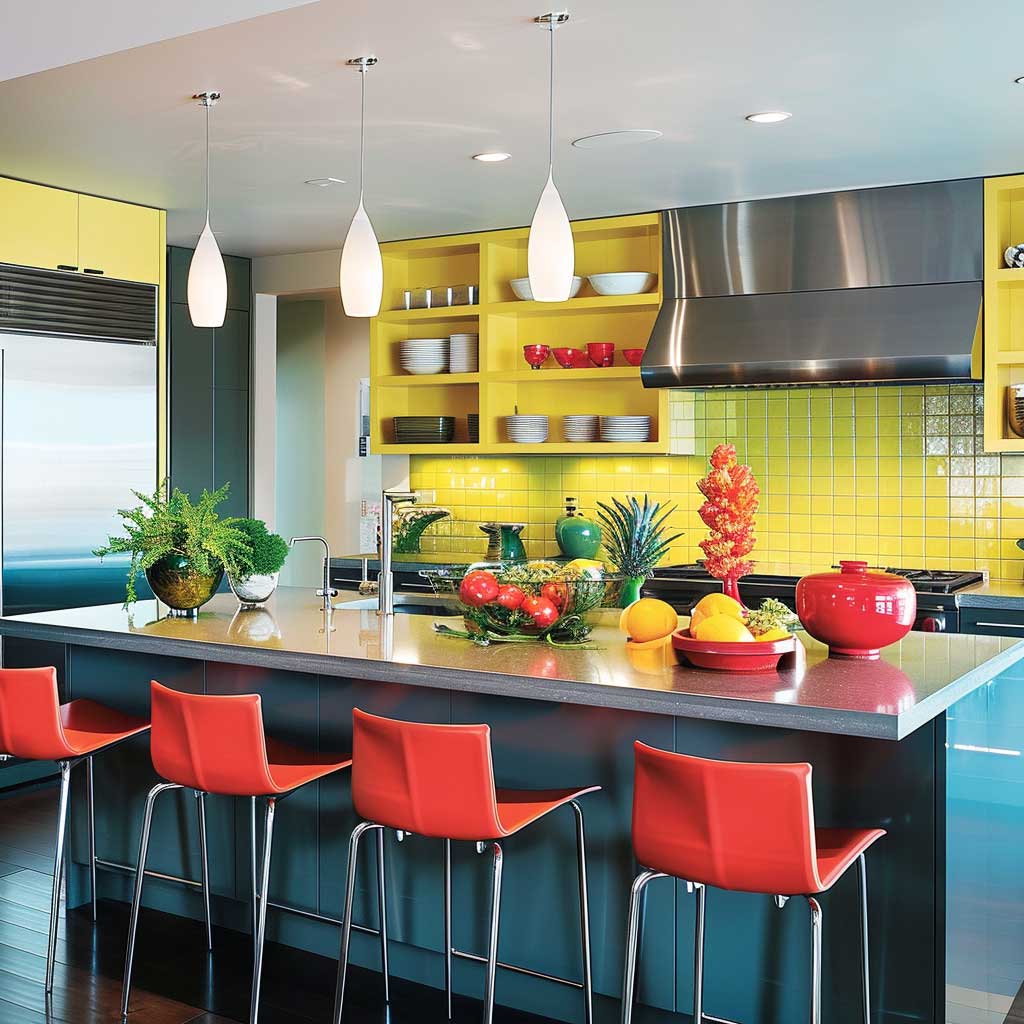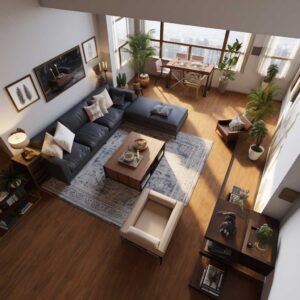Delve into the realm of contemporary kitchen design, where innovative layouts meet stylish decor. This exploration reveals how creativity and functionality can merge to form the heart of the modern home. Discover design strategies that maximize space efficiency, aesthetic appeal, and ergonomic comfort, redefining the conventional kitchen space.
Maximizing Space with Smart Contemporary Kitchen Design Solutions




In contemporary kitchen design, the intelligent use of space is paramount, especially in modern homes where efficiency is as valued as aesthetic appeal. The challenge and opportunity lie in crafting a kitchen that is not only visually appealing but also maximizes functionality in every square inch.
The cornerstone of smart space utilization in contemporary kitchens is the innovative layout. Designers are increasingly adopting open-plan layouts that blend the kitchen with living and dining areas. This approach not only creates a sense of spaciousness but also fosters a more social environment, where the kitchen becomes a central hub for interaction and entertainment.
In these modern kitchens, every component is meticulously planned. Multi-functional islands have become a staple, serving not just as additional worktops, but also as dining areas, storage spaces, and sometimes even housing integrated appliances. The versatility of these islands makes them indispensable in a contemporary kitchen, particularly in compact urban homes.
Efficient storage solutions are another critical aspect. Contemporary kitchens often feature custom cabinetry designed to utilize every available space. Innovations like corner drawers, pull-out pantries, and under-sink organizers ensure that every inch is used effectively, reducing clutter and enhancing usability.
Integrated appliances are a hallmark of modern kitchen design, lending a sleek and unbroken look to the space. Refrigerators, dishwashers, and even ovens are often built into the cabinetry, creating a seamless aesthetic. This integration not only saves space but also contributes to the minimalist and uncluttered feel that is synonymous with contemporary design.




The choice of materials and finishes plays a significant role in the perception of space. Reflective surfaces, such as high-gloss cabinets and stainless-steel accents, can make the kitchen appear larger by reflecting light. Similarly, glass features, whether in cabinet doors or as backsplash tiles, add depth and dimension, enhancing the sense of openness.
Lighting, both natural and artificial, is strategically used to create an illusion of more space. Large windows, often unadorned with heavy treatments, invite natural light in, making the kitchen feel airy and open. Artificial lighting is layered, with task lighting under cabinets, ambient lighting in the form of ceiling fixtures, and accent lighting to highlight architectural features or display areas.
The color scheme in contemporary kitchens also contributes to the feeling of spaciousness. Light, neutral colors are typically used to create a bright and airy feel. These are often complemented with pops of color through accessories or a feature wall, adding vibrancy without overwhelming the space.
Ergonomics is an essential consideration in maximizing space. The layout and placement of appliances, storage, and work areas are designed keeping in mind the ease of movement and the reduction of physical strain. This not only makes the kitchen more comfortable to use but also enhances safety.
In these kitchens, every detail, from the placement of sockets to the type of hardware used, is thoughtfully considered. The goal is not just to create a beautiful kitchen but to design a space that is highly functional and tailored to the needs of the user.
In summary, contemporary kitchen design is an exercise in balancing aesthetics with functionality. Through innovative layouts, smart storage solutions, integrated appliances, and thoughtful use of materials and lighting, these kitchens maximize space without sacrificing style. They reflect the needs of modern living, where efficiency, comfort, and beauty go hand in hand.
Fusion of Natural Elements in Modern Kitchen Decor




The integration of natural elements into modern kitchen decor represents a refreshing trend in contemporary kitchen design, where the charm of nature is fused with the sleekness of modern aesthetics. This approach creates spaces that are not only visually appealing but also provide a sense of tranquility and connection to the natural world.
The use of natural materials is at the heart of this design trend. Wood, stone, and metal are commonly used, each bringing its unique texture and warmth to the kitchen. Wooden cabinets, whether in a light, Scandinavian style or a rich, dark finish, add a sense of organic beauty. Stone countertops and backsplashes, such as granite or marble, provide durability and elegance, while metal accents in copper or brass inject a touch of industrial chic.
Incorporating greenery is another way to bring natural elements into the kitchen. Indoor plants, whether small herbs on the windowsill or larger potted plants, not only enhance the decor but also improve air quality. They add a vibrant splash of color and life to the kitchen, creating a more inviting and relaxing space.
The use of natural light is crucial in kitchens that embrace this design philosophy. Large windows, skylights, and glass doors maximize the entry of sunlight, illuminating the natural materials and plants, and establishing a seamless connection with the outdoors. This influx of natural light not only makes the space brighter but also helps to create a healthy and positive environment.




The color palette in these kitchens often draws inspiration from nature. Earthy tones, such as greens, blues, and browns, are combined with neutral shades to create a balanced and harmonious look. This color scheme resonates with the natural elements, enhancing the feeling of being connected to the outdoors.
Textures play a significant role in these kitchens. The tactile experience of different surfaces, from the smoothness of polished stone to the graininess of wood, adds depth and interest to the space. This variety in textures not only appeals to the senses but also helps to create a kitchen that is rich in character.
Sustainability is an underlying theme in the fusion of natural elements in kitchen decor. Eco-friendly materials, energy-efficient appliances, and sustainable practices are increasingly becoming part of contemporary kitchen design. Homeowners and designers are more conscious of the environmental impact of their choices, leading to designs that are not only beautiful but also responsible.
In summary, the fusion of natural elements in modern kitchen decor is a reflection of contemporary society’s desire for spaces that are not just functional but also provide a sense of wellbeing and connection to nature. Through the use of natural materials, plants, natural light, and a nature-inspired color palette, these kitchens offer a tranquil retreat from the hustle and bustle of modern life, while still embodying the sleekness and efficiency of contemporary design.
Creative Color Schemes Elevating Contemporary Kitchen Styles




The use of creative color schemes is a dynamic element in contemporary kitchen design, offering a canvas for personal expression and aesthetic innovation. These color schemes not only define the ambiance of the kitchen but also reflect the homeowner’s personality and style.
Contemporary kitchens often start with a neutral base. Whites, grays, and beiges create a clean and serene backdrop. This neutrality is not just about playing it safe; it’s about setting a foundation upon which creativity can unfold. Against this canvas, vibrant hues and subtle tones are carefully introduced to add character and depth.
Bold and unexpected color combinations are a signature of modern kitchen design. A classic monochrome palette might be invigorated with splashes of red or blue, bringing energy and vivacity to the space. Alternatively, pastel shades can be used to create a soft, inviting atmosphere, perfect for a kitchen that doubles as a gathering space for family and friends.
Accent walls, colored cabinetry, and unique backsplashes are popular ways to incorporate color into contemporary kitchens. These elements become focal points, drawing the eye and adding a layer of visual interest. The colors chosen for these features often reflect current trends, but they are also a reflection of individual preferences and lifestyles.




Textures and materials play a significant role in how color is perceived and experienced in the kitchen. Glossy surfaces reflect light and can make colors appear more vibrant, while matte finishes offer a more subdued look. The interplay of different textures can enhance the impact of the color scheme, adding a tactile dimension to the visual experience.
Lighting, both natural and artificial, is key in showcasing these color schemes. The right lighting can bring out the true hues and nuances of the colors used, changing the mood of the kitchen throughout the day. Adjustable lighting solutions, such as dimmer switches and color-changing LED lights, allow for flexibility, adapting the space to different activities and times.
Color psychology is often considered in contemporary kitchen design. Warm colors, like red and yellow, are believed to stimulate appetite and create a cozy, welcoming environment. Cool colors, such as blue and green, are thought to have a calming effect, making them ideal for creating a relaxed atmosphere.
In summary, creative color schemes in contemporary kitchen design are not just about following trends; they’re about creating a space that resonates on a personal level. Whether through bold contrasts, subtle harmonies, or innovative combinations, color is used to elevate the style and mood of the kitchen. It transforms the space into an area that is not just functional but also a true reflection of the homeowner’s taste and personality.












